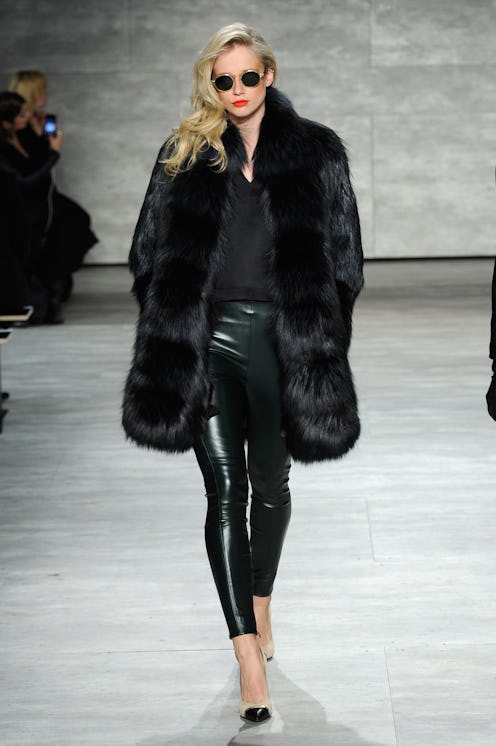There's no denying it: Fur is back in a real way. From the high-fashion runways to the casual streets, in coat, vest, or earmuff form, it's pretty much everywhere. But more often than not, it's likely a faux version. There's been a huge push in the fashion industry to put an end to using real fur in favor of faux. And while most everyone (designers and models alike) has embraced this new anti-fur movement, many are questioning if the rise of faux fur is hurting the environment.
Mike Moser, chief executive of the British Fur Trade Association (not exactly an unbiased source, I know, but bear with me), told The Daily Mail UK that young fashionistas are clueless about what their faux-fur obsession could be doing to the earth. "There isn’t any doubt that the environmental impact of fake fur is profoundly worse than fur-farming," he said. What he means by that: Fake fur is made from non-renewable petroleum-based products, like nylon, acrylic and polyester, which is then treated with heat and chemicals to improve its look and feel. According to the International Fur Trade Federation, these industrial processes use three times as much non-renewable energy as real fur.
Of course, killing endangered animals solely for their coats is abhorrent and inexcusable. Yet, even some anti-fur supporters see where fur advocates are coming from. Costume designer Minna Attala told The Daily Mail, "Killing animals for vanity is not right, but there are whole communities of people who rely on this industry for employment, and, in the majority of cases, the animals are treated well, so that they’ll have healthy coats."
It's a tricky topic, for sure. To help you better figure out your stance, here's a list of the pros and cons for the faux fur argument.
PROS
1. Not Harming Animals: This is, obviously, the biggest part of this argument. By using fake fur, you'd be helping put an end to the bloody fur trade industry. Your conscience would feel lighter knowing that no animals were harmed to make your faux fur vest happen. Maybe you're a vegetarian too, or just feel that eating a cheeseburger for sustenance is totally different from wearing an animal for style.
2. Faux Fur is Cheaper: Perhaps you're unaware of the costs of real fur? Well, it ain't cheap. Faux fur is a much more affordable alternative since it relies on inexpensive materials like synthetic fibers.
3. It's Easier to Take Care Of: You don't have to worry about storing or caring for faux fur the way you would with a real fur coat. It'll maintain it's soft and shiny appearance for as long as you have it.
4. Dyeing Real Fur is Just as Environmentally Unfriendly: PETA’s UK director Mimi Bekhechi claims that a "cocktail of carcinogens" including ammonia, chromium and formaldehyde are used in dressing and dyeing real fur, which completely negates its biodegradability, making it just as bad for the environment.
CONS
1. Fake Fur is Not Environmentally Friendly: Unlike real fur, fake fur is not biodegradable. According to The Daily Mail, faux-fur garments typically end up in a landfill and "just like petroleum-based plastic bags, can take up to 1,000 years to decompose." Real fur can biodegrades naturally within six months to a year.
2. It's Not as Warm as Real Fur: Real fur can withstand harsh weather conditions and prevent snow from freezing, unlike most faux fur.
3. Real Fur is Arguably Prettier and Softer: Much like vegan leather, faux fur just isn't as smooth or beautiful as the real thing. Although many designers are working hard to create goods made from really good fake leather and fur materials, it's difficult to truly replace the genuine thing.
Although the cons are important, I'm still firmly pro-fur. Where do you stand?
